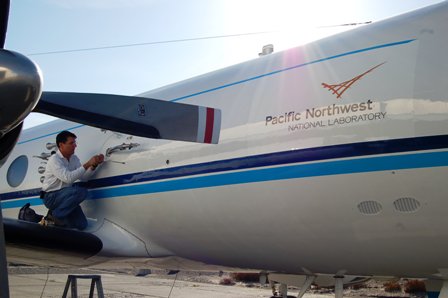Atmospher Sci & Global Chg
Research Highlights
October 2008
Climate Researchers Say "Hola" to Chile for Six-Week Field Study
Summary: Researchers from Pacific Northwest National Laboratory traveled to the Chilean coast in October and November to spend six weeks participating in an international field study that will generate new insights about climate change. The purpose of the Variability of the American Monsoon Systems Ocean-Cloud-Atmosphere-Land Study is to better understand the interactions among the ocean, clouds, air, and land in the Southeastern Pacific. PNNL is among 40 institutions from 8 nations that have 150 scientists contributing to this field study.
The PNNL contingent is taking part in the U.S. Department of Energy's Atmospheric Science Program's component. Their focus is on how precipitation forms in clouds and how aerosols affect cloud optical and microphysical properties. The data they collect will provide new insight into the complex relationships between aerosol and cloud properties, which substantially affect climate change.

Researcher John Hubbe adjusts a temperature probe on the G-1 Gulfstream research aircraft in preparation for the 2008 field campaign in Chile.
Why it Matters: The climate system in this region not only influences climate throughout the world—rainfall and temperature patterns—but also impacts the regional fisheries that account for one-fifth of the world's fish catch. In addition, this climate system is not well understood and has not been represented well in climate models. Although previous studies have been conducted of aerosol and cloud properties under similar conditions, the studies were limited by available data.
This area off the Chilean coast has one of the largest marine cloud layers in the world, and it covers the sky nearly year-round. This combined with the fact that this marine cloud coverage reaches its peak in October—about 70 percent—provides a perfect opportunity to gather needed data.
Methods: PNNL scientists are conducting measurements using the U.S. Department of Energy's Gulfstream-1 research aircraft from a base in Arica, Chile. This instrumented aircraft will fly several patterns off the Chilean coast, at various altitudes, below, within, and above clouds.
What's Next: The scientists will use data obtained during this study to examine the validity of recently developed computer model representations designed for use in global climate models. The result: More realistic predictions of climate change and its effects.
Research Team: The PNNL participants include facility coordinator and scientist John Hubbe; scientists Dr. Liz Alexander, Dr. Alex Laskin, Matt Newbum, and Dr. Mikhail Pekour; and pilots Bob Hannigan, Dick Hone, and Bill Svancara. The PNNL team also is collaborating with scientists from Brookhaven National Laboratory on this study.
Acknowledgments: PNNL is strengthening U.S. scientific foundations for innovation by transforming the Nation's ability to predict climate change and its impacts. This work was supported through the U.S. Department of Energy's Atmospheric Sciences Program.
